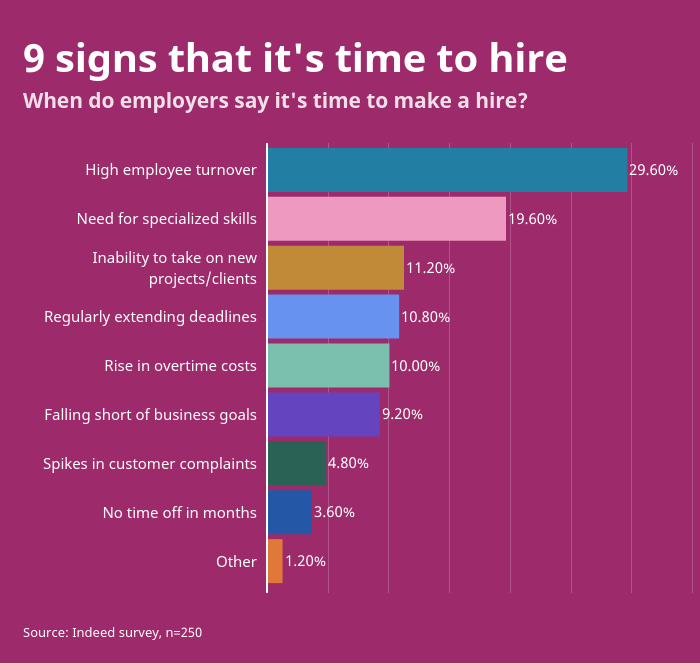How to hire employees in 10 steps

1. Do your research
Review job descriptions for similar roles to better understand what skills and experience apply to your open position. Monitoring job trends can also help your hiring team identify industry-specific job titles, relevant keywords and salary information.
Consider running a recruiting event to generate excitement about your company’s job opportunities. These events can expand your recruiters’ reach and create organic leads to follow up on later.
2. Create an enticing job description
A carefully crafted job description can be a valuable hiring tool. Incorporating strong keywords, compensation information and accurate descriptions of the job’s responsibilities and duties can encourage job seekers to apply. Consider including details about company culture and benefits to set your company apart.
3. Review applicant resumes
To determine which applicants to interview, look for information on their resume that indicates their skills, motivations, experience and work style:
- Past achievements
- Attention to detail
- Skills and experience tailored to the job description
A culture add approach to hiring employees can also be effective. Considering applicants with a unique background or skill set might bring new ideas and perspectives to the team.
Filter out applicants who don’t match the key job requirements by sending them a rejection email. (Indeed has a built-in rejection message you can send with the click of a button.)
4. Conduct interviews
When interviewing candidates, consider starting with a quick 15- to 30-minute phone screening to determine whether they meet the basic job qualifications and if your role aligns with their expectations.
Approaching the interview process with a list of interview questions specific to the industry and role can help interviewers make informed hiring decisions. Taking notes or using an interview scoring rubric may also make it easier to evaluate and compare candidates objectively.
Consider whether you’d like to use behavioral or situational questions. Behavioral questions primarily address past experiences to assess future behaviors. These questions can help you evaluate whether the candidate may be a good addition to the team.
Some examples of behavioral questions include:
- Have you ever made a mistake at work, and if so, how did you handle it?
- Can you share a time in your previous role when you had to collaborate with others to achieve a common goal?
- Tell me about a time you disagreed with a colleague. How did you settle it?
Situational questions typically demonstrate how a candidate thinks, which can show how they may respond in certain scenarios. You may ask:
- What would you do if asked to complete a task you have no experience in? What are the steps you would take?
- If you encountered a difficult interaction with a customer, how would you help support a positive customer experience?
- If asked to lead the team in a project of your expertise, what leadership qualities would you want to demonstrate?
5. Check references
References can provide additional insights and verify skills listed on a candidate’s resume. They can also ensure you’re hiring employees who are honest about their work experience and qualifications. Consider requesting one to three references from your top candidates.
Here are some questions to ask during a reference check:
- Can you confirm the candidate’s job title, responsibilities, start and end dates, etc.?
- How long have you known/worked with the candidate?
- Tell me about what it’s like to work with the candidate.
- What are their biggest strengths and weaknesses?
- What key skills did the candidate add to your team/company?
- How did they adapt to a fast-paced work environment?
- In what ways did the candidate excel with collaboration?
- What was the candidate’s workplace communication style?
- What leadership qualities did the candidate demonstrate?
- How did they handle constructive criticism?
- Would you work with this person again?
6. Select the candidate you want to hire
Consider how your candidates may add to your team and company culture. To help make a decision, reflect on what you’ve learned about the different candidates’ skills, personalities and experiences from their resumes, interviews and references. Look for individuals who can help solve roadblocks and contribute to company goals.
Read more: Employee Selection Process: 9 Steps to Your Next Hire
7. Make an offer of employment
Before sending the official offer letter, contact the candidate to set up a time to talk over the phone. During the call, express excitement about inviting them to join your team and present the terms of your offer, including salary, benefits, start date, etc. If the candidate accepts your verbal offer, send an official written letter.
8. Notify rejected candidates as soon as possible
Part of knowing how to hire staff is notifying candidates of a rejection promptly and respectfully. You can deliver the update by phone or email. Be honest but supportive, and consider offering constructive feedback to help them in their search elsewhere.
9. Refine your new hire onboarding process
Understanding how to hire workers involves being aware that the process continues after the job offer. Effective onboarding may help new employees feel welcome and support their success in their positions.
Consider these tips when creating a memorable onboarding process:
- Set up a team lunch for the first day or week so everyone on the team can get to know each other. You might schedule a weekly coffee hour for remote teams during lunch or late morning.
- To help the new employee feel connected to your brand, you could provide a free bag of branded items, such as a pen, T-shirt or mug.
- Connect the new employee with a mentor who can help them transition into their new role.
10. Measure your success
Learning how to hire people is a continuous task, and tracking your team’s progress can help you make additional adjustments. Indeed allows employers to generate performance reports from their employer dashboards to find out how their job postings perform.







